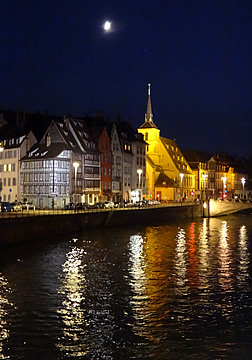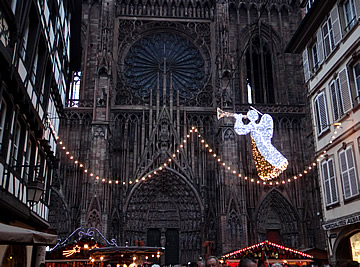


An historic city with a fine cathedral and a great Christmas Market.

Strasbourg is very easy to get to from Basel so we've visited several times, but we actually stayed overnight there in August 2014 on our way back from Heidelberg. It's at the top end of the Alsace region of France a long green stretch of countryside on the east side of the Vosges mountains dedicated to vineyards.
There has been a sizeable settlement here for well over two thousand years on the west bank of the Rhine, on the border of the Germanic and and Roman, now French, states, and it was recognised as a good location to guard routes between the two worlds. Military settlements grew and prospered but with the departure of the Romans in the 4th century the city became vulnerable to attack and was destroyed and rebuilt many times. The then-named Argentoratum morphed into Strateburgum ("City of Roads") under the Franks, a group of Germanic tribes originating east of the Rhine.
During its long history Strasbourg has alternated many times between French and German rule, most recently during the Second World War when Germany annexed the Alsace, until the city was liberated by the Allies in November 1944.





We stayed in the excellent Hotel Cour du Corbeau. It is a beautiful historic place - a hotel has stood here since the early sixteenth century and much of the hotel architecture dates from that time.1 The hotel is very well-located too, on the south side close to a bridge across the canal surrounding the Grande-Île de Strasbourg where the cathedral stands.




The cathedral was completed in 1439 in true Gothic style, with an immensely tall spire. The region, including Basel to the south, was a bastion of Protestantism in the Reformation of the sixteenth century, though much of the Alsace remained Catholic. In order to maintain peace the cathedral was used by used by both faiths from 1592, with two bishops installed.


Though the Thirty Years War ravaged the region, Strasbourg escaped. It had powerful fortifications but, more importantly, it made a pact with the Habsburg Holy Roman Emperor Ferdinand II that the city would remain neutral. In return, Ferdinand allowed the city to found a university.
Now the city is most famous as the official seat of the European Parliament.


We had an excellent lunch at Winstub zum Strissel. Coq au Riesling for Andrew and an incredible leg of pork for me - gorgeous and absolutely huge! We finished with a shared Tarte flambée aux pommes et au Calvados - superb!





In the evening there was a rather impressive light show at the cathedral.




The following morning we had a bit of a wander around picturesque Petite France on the Grande-Île before heading out.

In late November the same year we returned to Strasbourg for the Christmas Markets. Travelling by train from Basel there was no need to stay overnight, but it made for a long day.
The city boasts ten Christmas markets, so there is plenty to see, and the city is beautifully decorated, I particularly liked the angels.




As usual at the Christmas markets we had lunch from the many choices on offer - tarte flambée, in this case, and crepes - Calvados, but Grand Marnier pronounced better.












